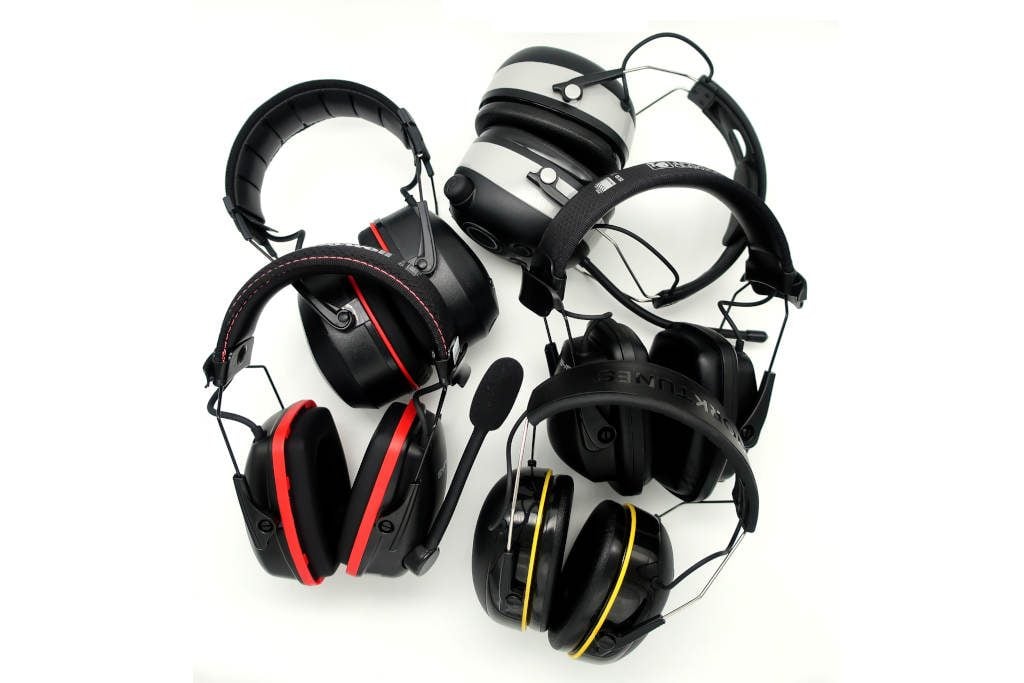
I purchased all Bluetooth earmuffs reviewed here at standard retailers and put them through some good testing. This post reports on my findings and personal favorites.
Bluetooth hearing protection earmuffs can spice up your work day and make you more productive:
Listen to music or audio books with the built-in headphones while protecting your hearing from loud noise (e.g., while mowing the lawn, landscaping, or doing metal or wood work).
Learn new things, keep up with the news, and take client calls while working.
And, some of these earmuff headphones are an economical option for people who don’t need a hearing protector but want to block out distractions, such as students and office workers.
To find the best Bluetooth hearing protecting earmuffs, I have put my shortlist through a detailed test procedure that included:
- Wearing them as passive earmuffs to protect against loud noise (lawn mower noise at 95 decibels and metal saw at 98-100 decibels).
- Listening to music, podcasts, and audiobooks under the same loud conditions.
- Making phone calls in a moderate-noise environment.
- Making phone calls in a loud environment (mower at 95 dB, metal saw at 98 dB, and router at 100 dB)
All Bluetooth earmuffs in this review are complete headsets and have a built-in microphone, allowing you to answer phone calls without taking off your hearing protector.
Before going into more details, here is a brief overview:
All earmuffs are very similar in their effectiveness as a hearing protector and all worked reasonably well for listening to music when it is loud.
But some worked clearly better than others…
What distinguishes them are sound quality and sophistication of safe volume control, wearing comfort, and the ability to make phone calls in a very loud environment.
Making calls generally worked well as long as the noise level was moderate.
But, only one headset allows you to actually make phone calls while running a lawn mower, router or saw at full throttle.
Contents
Bluetooth hearing protection earmuffs overview and ranking
Note: Points out of 10, 10/10 is best.
| Rank (Overall) | Earmuffs | Sound Quality | Comfort | Calls (Loud Noise) | Calls (Normal) | Adjust (large heads) | Max Volume (BT) | Weight | Remarks |
|---|---|---|---|---|---|---|---|---|---|
| 1 | 3M Worktunes Connect + AM/FM | 9 | 7 | 1 | 6.5 | 9 | 7.5 | 402g (14.2 oz) | Best Sound Heavy |
| 2 | 3M Worktunes Connect | 8 | 8.5 | 1 | 6.5 | 8 | 8 | 347g (12.2 oz) | Clearest audio books Volume +/- on phone |
| 3 | Honeywell Sync Wireless | 7 | 8.5 | 8 | 9 | 7 | 7 | 310g (10.9 oz) | Best call quality limited adjust-ability |
| 4 | Howard Leight Sync Stereo + Bluetooth receiver | 7.5 | 8 | 1 | 7 | 6 | 9 | 253g (8.9 oz) | Lightest Not for large heads |
| 5 | Tasco Connex | 7.5 | 7 | 1 | 7 | 8 | 6.5 | 342g (12.1 oz) | Spacious for large ears A bit quiet |
Review of my top 5 Bluetooth hearing protection earmuffs
Comparison criteria
- Overall noise reduction
- Comfort, weight, ear pad cushions and ear cup opening size
- Headband adjust-ability
- Sound Quality
- Listening to music, podcasts, and audio books in a loud environment (lawn mower, metal saw)
- Answering Calls under moderate and loud noise (street, lawn mower, metal saw, router)
- Bluetooth connection stability
- Ease of Operation and Bluetooth pairing
1. 3M Worktunes Connect + AM/FM ♦
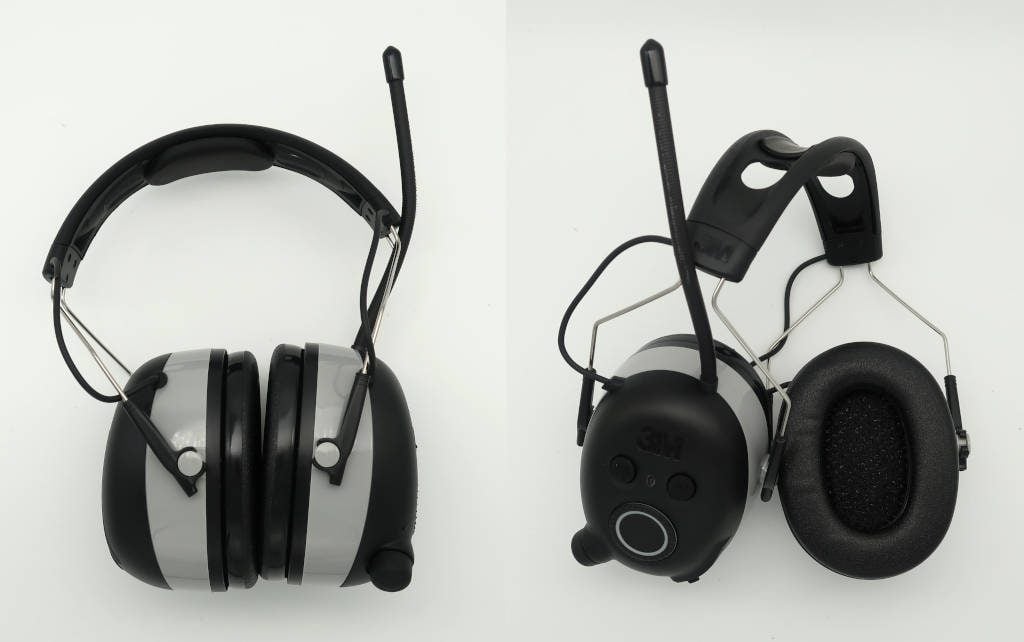
The Worktunes Connect + AM/FM are my favorite Bluetooth work earmuffs. They are the best sounding Bluetooth earmuffs I have found so far and they offer a great all-around package.
They have a good bass, full-bodied vocals, and transparent highs, without sounding harsh.
These muffs are a lot of fun listening to whether via Bluetooth, radio, or a wired audio source.
All hearing protection headphones limit the maximum permissible volume, but the Worktunes Connect + AM/FM have the best safe volume control:
They employ a noise dosimeter that attempts to limit the average sound level over the course of a work day but allows you to listen at a louder volume for periods of time.
The advantage: it doesn’t negatively affect the sound quality as some other volume limiters do.
With most music and audiobook sources, I found the volume perfectly adequate even under loud conditions (up to about 98 decibels).
In the past, these earmuffs didn’t have a microphone, but now 3M has upgraded them:
You can make and take phone calls. This works OK as long as you turn off your machine and then take the call.
However, these and almost all other Bluetooth earmuffs don’t work for making calls when it is noisy: The microphone doesn’t separate the noise from a lawn mower/other machinery from speech.
Under these circumstances my calling parties couldn’t understand me at all.
To spare you any cross-checking: Only the Honeywell Sync Wireless headset (the communication king below) allows you to communicate in a loud environment (I tested this up to 100 dBA).
Battery life: I got about 40 hours of Bluetooth listening (two disposable AA alkaline batteries). 3M offers an optional rechargeable lithium battery pack, which can be charged via the micro USB port.
Pros:
- Great sound quality for music, audio books, podcasts, and radio.
- Volume-control method (via a dosimeter) allows for a good volume and doesn’t impair sound quality.
- The most adjustable Bluetooth earmuffs: These should fit even very large heads.
Cons:
- I find them reasonably comfortable, but at 402 g (14.2 oz) they are a bit heavy. This can affect the stability if you need to do overhead work.
- The Headband works well with a baseball cap but can become uncomfortable after a few hours when not wearing a cap. (Readjusting the muffs helps.) (See below for an additional headband cover.)
- To pair them with another device, you have to disconnect the muffs first (in the Bluetooth settings of the active device). (With other muffs pressing a button on the muffs is sufficient).
Update: These days, I use the Worktunes Connect + AM/FM with an additional headband cover, made by U.S. Tactical Sewing. This has made the earmuffs a lot more comfortable and increased the stability. Recommended!
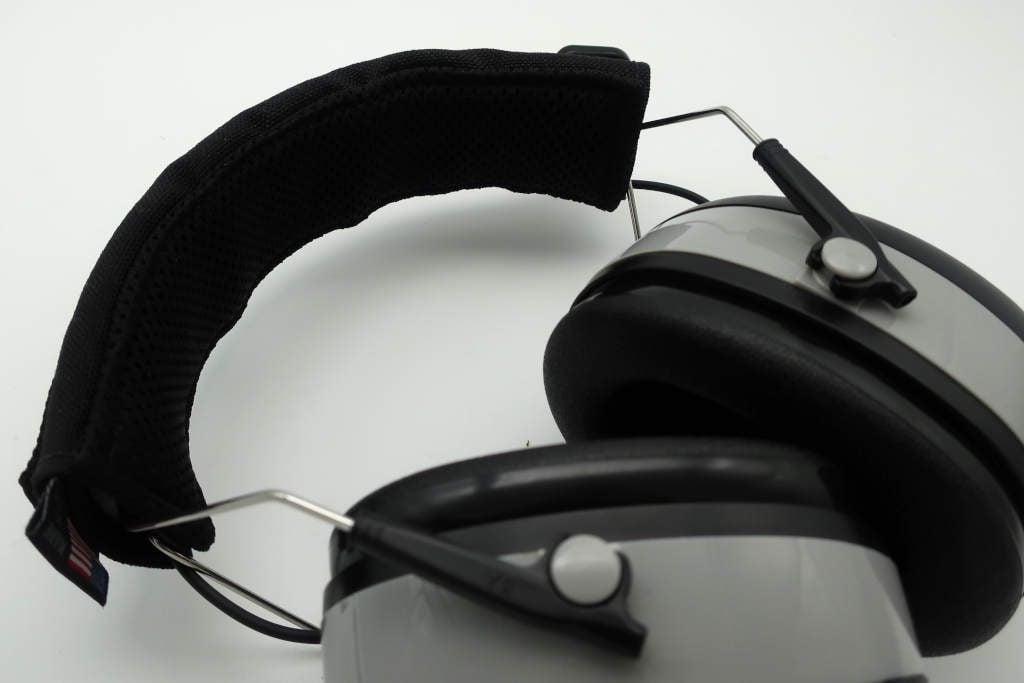
2. 3M Worktunes Connect

At the time of this review, the Worktunes Connect (without radio) are the most economical Bluetooth earmuffs. They reduce noise well, sound good, look very sleek and have a built-in rechargeable battery that lasts for nearly 40 hours of play time. (Only these and the Honeywell Sync Wireless have a rechargeable battery.)
These earmuffs employ a volume limiter that allows for quieter passages and audiobooks to be heard louder while at the same time reducing louder passages to a maximum output of 82 decibels (compression-type limiter).
Because of this limiter, I find even quiet music, podcasts and audiobooks easy to understand when in a loud environment (98 decibels)—even easier than with the Worktunes Connect + AM/FM.
What’s more, the Worktunes Connect emphasize the lower frequencies. This helps against being drowned out by lawn mower noise.
Their sound signature is somewhat darker and less transparent than that of the Worktunes Connect + AM/FM but I quite like it.
The main advantage of the limiter of the Worktunes Connect can also be its downfall: when you play them at a good volume to enjoy the vocals (while mowing the lawn) and then suddenly the drums kick in, the limiter reduces the volume of the drums, i.e., compressing the dynamic range of the music, so as to not exceed a safe listening limit.
But we are talking about listening in a very loud environment and hence I prefer this to the reduced output solution most other earmuffs employ.
In a quiet environment, I can keep the volume at a level so that the limiter doesn’t kick in.
Perhaps, in the future 3M can add the noise dosimeter to these earmuffs as well, so users can choose between dosimeter and limiter according to their needs.
Battery life: I got about 38 hours of Bluetooth listening (built-in rechargeable lithium battery).
Pros:
- Decent music sound quality with an emphasized bass and great podcast/audio book voice quality.
- Compression-type limiter allows for good volume even with quieter music and audio books.
- Comfortable and well-adjustable earmuffs.
- My favorite Bluetooth earmuffs for blocking out distractions, e.g., for students and office workers.
Cons:
- At a loud volume the limiter reduces the dynamic range of music and can lead to a “pumping perception.” You hear the singer really well and then the limiter unexpectedly reduces the kick drum’s volume.
- Volume adjustment is via your phone; no volume control buttons on the muffs.
- Ear cups are a bit shallow. My ears would prefer a bit more space.
Update: In the meantime, I have also gotten 3M’s gel replacement ear cushions for the Worktunes Connect.
(3M wasn’t offering this kit when the Worktunes Connect first came out.)
I find both the foam and the gel cushions comfortable, but the gels are deeper and have a larger opening, giving my ears more space.
In my opinion, if you have large ears or are wearing glasses, these gel cushions are definitely worth considering.
In any case, you can always start with foam and see how you go.
Moreover, if you are using your earmuffs a lot, the ear pads will eventually wear out: you don’t need to buy new muffs; just get these economical replacements ear pads.
If you need more information, I have done a comprehensive review of the 3M Worktunes Connect.
3. Honeywell Sync Wireless Earmuff with Bluetooth (the communication king)
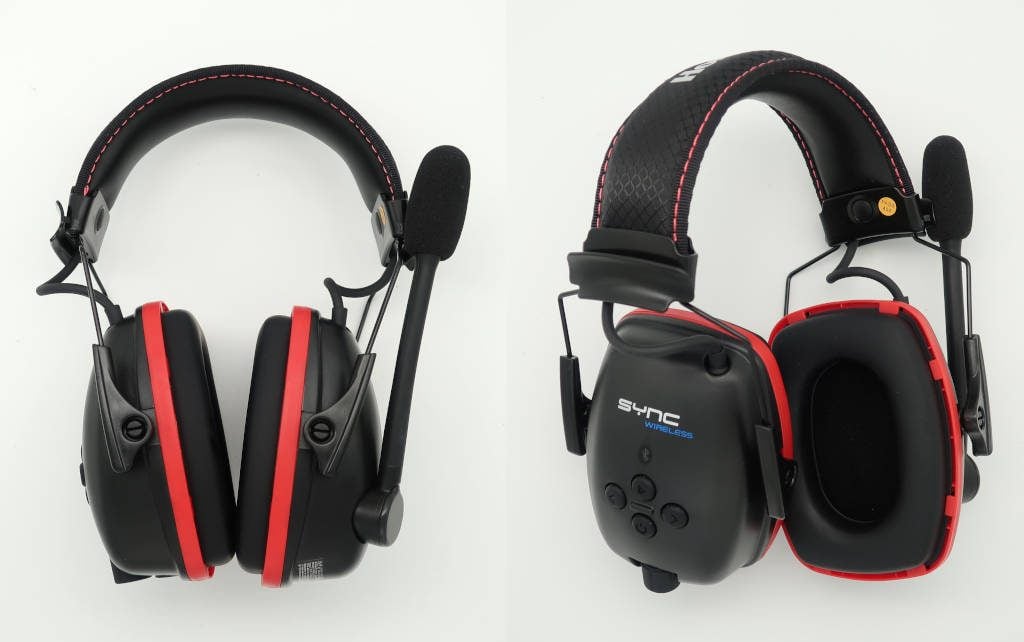
The Honeywell Sync Wireless Bluetooth earmuffs with their boom microphone are great for making phone calls.
And, they are the only earmuffs in this review that allowed me to take calls amidst loud noise reaching up to 100 dBA, including lawn mower, metal saw, and router noise.
With all other muffs, my voice simply disappeared in the noise.
With these, my calling partners were always able to hear me, and I was able to hear them. When asked about the call quality, one person noted that there was a bit of wind noise (which was in fact lawn mower noise).
The Sync Wireless eamuffs are very comfortable (with enough space for my ears) and light and offer a very stable fit.
But, I have to fully extend the muffs’ headband to wear them. I have a slightly larger than average head, so if you have a large head these might not extend enough. A friend of mine with an average head felt they were perfect.
I found this to be an issue with many Honeywell / Howard Leight earmuffs. I wish Honeywell upgraded their standard head to a larger model.
These earmuffs sound alright with music: the highs are detailed, but the headphones seriously lack bass. They work well for podcasts and audiobooks, but in terms of sound quality, I much prefer both Worktunes earmuffs.
However, if your priority is making phone calls (while also being able to listen to music and audio books) there is no doubt that I would get these. No other microphone worked against loud noise.
Battery life: I got 25 hours of Bluetooth listening (built-in rechargeable lithium battery). Honeywell states 16+ hours.
Pros:
- These are by far the best earmuffs for making/taking phone calls in a loud environment. None of the others come even close. If your number-one priority is communication, these are the ones.
- Light-weight, comfortable and large-size ear cup openings.
- Very stable fit, suitable for overhead work.
Cons:
- Limited adjustability for large heads: I have a slightly larger-than-average head and these earmuffs do fit, but I have to extend them to the max.
- They sound transparent and clear but the music lacks bass. In terms of sound quality they are no match for the Worktunes Connect + AM/FM.
4. Howard Leight Sync Stereo MP3 Earmuff with external Bluetooth adapter
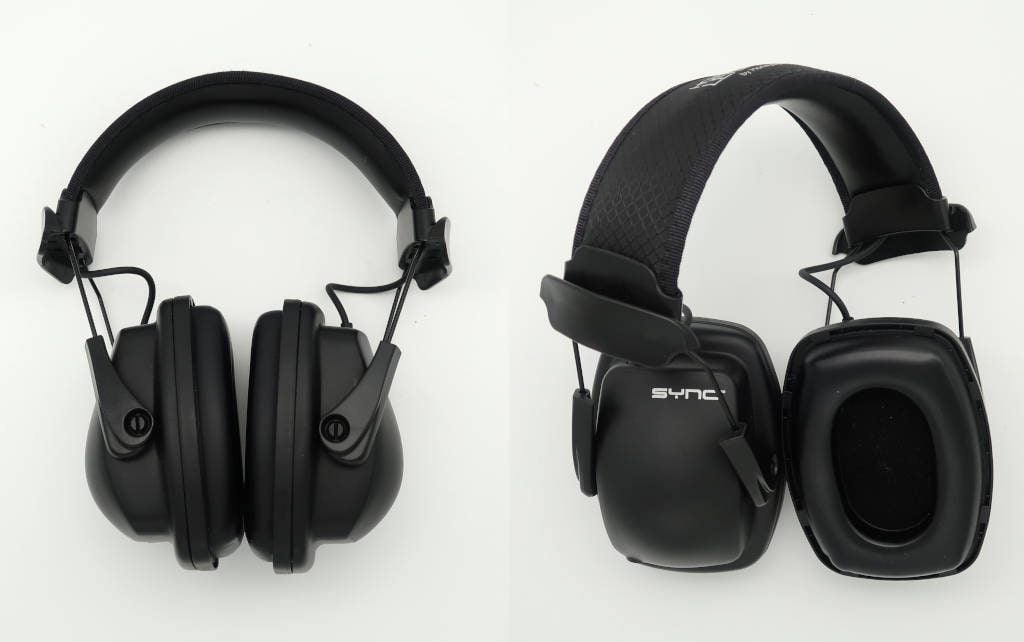
The Howard Leight Sync Stereo were my first eamuffs with built-in headphones.
Note: Howard Leight is a subsidiary of Honeywell.
By default, the Sync Stereo are wired and not Bluetooth earmuffs.
But they work very well with an external Bluetooth receiver (has to be purchased separately).
I currently use them with the Mpow BH203 Bluetooth adapter.
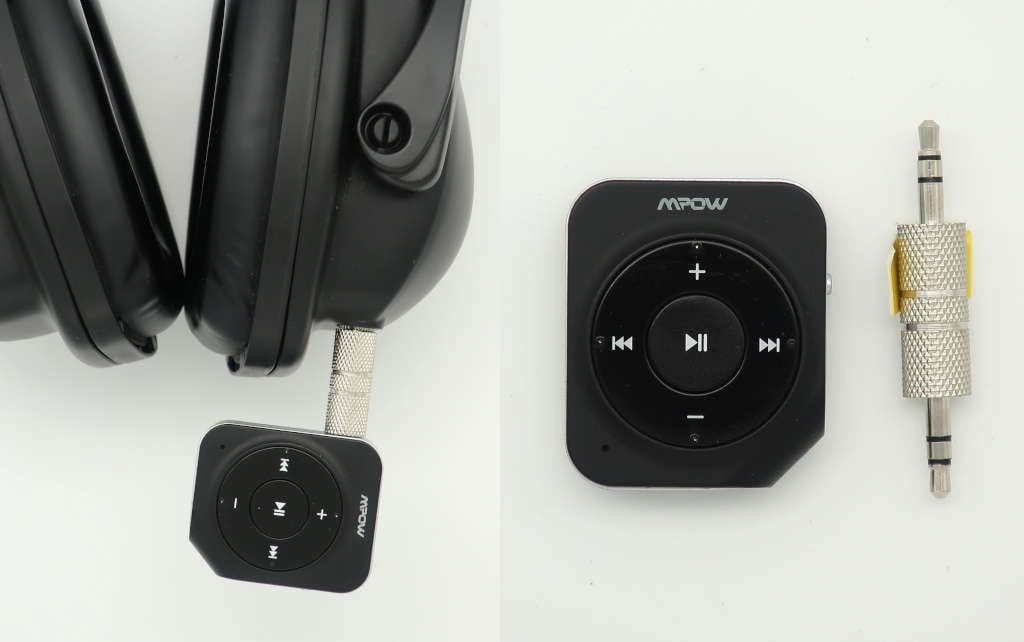
These muffs are very light, and usually cheaper than all other options.
The Sync Stereo in combination with the Mpow BH203 Bluetooth receiver get louder than all other muffs reviewed here.
The Sync Stereo’s volume limiter seems to rely solely on the output of your device not exceeding a certain volume, so you have to exercise caution and be sensible!
Howard Leight is a subsidiary of Honeywell, and while these share some similarities with the Honeywell Sync Wireless, IMO, these offer more bass.
They can sound a bit bright and at times harsh, but unlike the other muffs, they can quite easily be equalized to take the sting out of the highs.
I definitely prefer the sound of both Worktunes earmuffs to the Sync Stereo, but these have their own advantages:
The Sync Stereo are by far the lightest earmuffs in this review, they are comfortable (if your head is small enough), and they offer a good amount of space for the ears.
Unfortunately, like with the Sync Wireless, the headband of the Howard Leight Sync Stereo doesn’t fit large heads. They feel even smaller than the Sync Wireless on my head.
Battery life: With the MPow BH203 Bluetooth receiver, I got about 15 hours of Bluetooth listening (built-in rechargeable lithium battery).
Pros:
- They are very light.
- Usually the most economical choice.
- Comfortable for people with smaller heads (ear cups offer enough space for most ears).
- Louder than other earmuffs.
Cons:
- The least headband adjustability of all muffs: If you have a larger head, these will likely not fit.
- Sound is a bit on the bright side.
- A bit more hassle: you have the complexity of the additional Bluetooth receiver, either clipped to your shirt (my preferred solution) or attached to the earmuff itself.
For more information, please read my detailed review of the Howard Leight Sync Stereo.
5. CONNEX Bluetooth Hearing Protector Earmuffs by TASCO
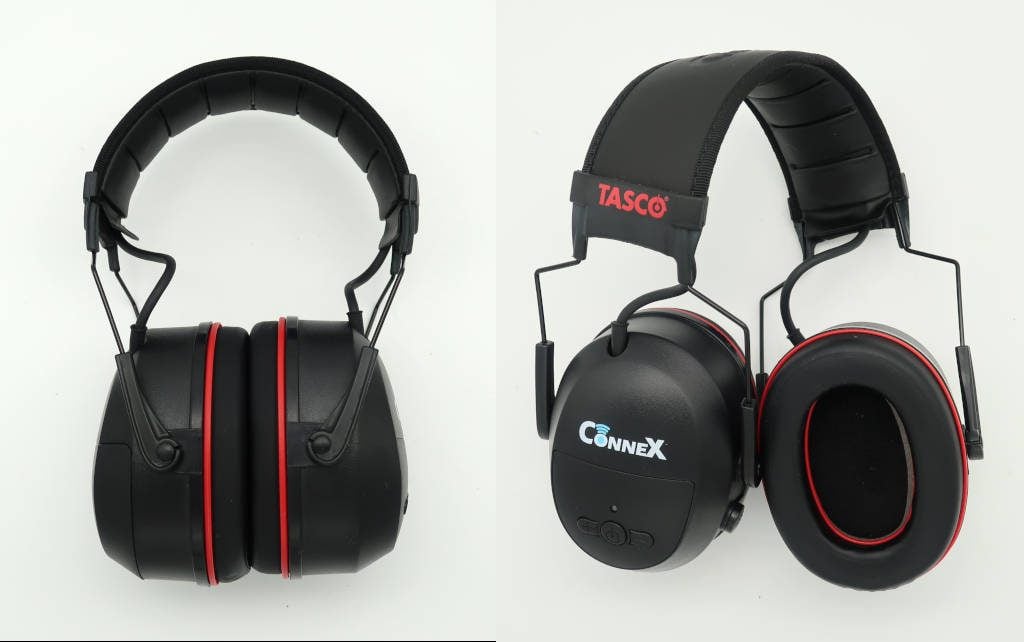
As hearing protection earmuffs, the TASCO Connex Bluetooth are very solid. They provide the most space for the ears and plenty of adjustability for most heads, and they reduce noise well. It shows that TASCO has many years of experience designing earmuffs.
The fit of these earmuffs is very stable, so they should work well if you need to do overhead work.
I find them comfortable but not as much as the Worktunes Connect (without radio) or the Honeywell Sync Wireless. The headband force appears to be a bit higher, which likely contributes to the very stable fit but reduces comfort somewhat.
On the other hand, if you have large ears you will appreciate the ample space the ear cushions provide.
The sound of these earmuffs is balanced and they have somewhat more bass than the Honeywell Sync Wireless, but overall the sound lacks sparkle.
In my listening tests, these got less loud than the other earmuffs, but generally, I still found the volume sufficient.
Some podcasts and audio books and quieter music were more difficult to understand in a high noise environment (>95 decibels) than with the other earmuffs reviewed here. It may also be the reserved sound signature that causes this.
In any case, I prefer the sound and volume limiter of both 3M Worktunes earmuffs and the Howard Leight Sync Stereo for listening to audio in a loud environment.
All in all, the Connex earmuffs are decent Bluetooth work headphones, but when I bought them they were a lot more expensive than the 3M Worktunes Connect without offering more.
Consider them at a price comparable to the 3M Bluetooth earmuffs if you have large ears or need to do a lot of overhead work.
Battery life: I got about 50 hours of Bluetooth listening (three disposable AAA alkaline batteries).
Pros:
- Good adjustability, works for most head sizes.
- Ear cups provide ample space for large ears.
- Very stable fit: good for overhead work.
Cons:
- Sound signature and volume limiter sometimes make them a bit quiet in a noisy environment.
- Unlike with the other Bluetooth earmuffs reviewed here, if you have connected the Connex to a wired audio device, you can’t take calls via a Bluetooth-connected phone. (In wired mode, you won’t even hear an incoming call.)
- At the time of this review these earmuffs cost significantly more than both the 3M Worktunes Connect + AM/FM and the 3M Worktunes Connect, but as headphones they offer no unique advantages.
Noise reduction
All earmuffs came with the EPA label stating the NRR on the box. This label (in a standardized format) needs to accompany all hearing protectors sold in the U.S.
All of them also included the required usage example and supplemental attenuation data by frequency (ANSI S3.19-1974) on which the NRR is based.
The noise reduction rating (NRR) for these earmuffs is very similar (NRR 24 and NRR 25, see table below).
My qualitative tests under loud noise and subjective impression are in line with that.
Depending on the noise source there were minor differences, but I would rank these earmuffs equally for their noise reduction.
Because the Honeywell and Howard Leight earmuffs are a bit on the small side for my head, the seal breaks easier (letting noise in) when I completely turn my head to the side. This may not be a problem for people with smaller heads.
With the Tasco Connex earmuffs, I needed to completely follow the adjustment procedure every time for maximum noise reduction, but then they provided a good seal and very stable fit: “Fully extend the headband; put them on; adjust the headband.”
When I did that, they worked like a charm.
If you need a higher noise reduction rating (e.g, NRR 30) for your work environment, more effective passive hearing protection earmuffs without Bluetooth are available.
Unfortunately, I am not aware of any NRR-30 earmuffs with built-in Bluetooth headphones.
Noise attenuation table (in dB, SD in parentheses)
| Earmuffs | NRR | 125 Hz | 250 Hz | 500 Hz | 1000 HZ | 2000 Hz | 3150 Hz | 4000 Hz | 6300 Hz | 8000 Hz |
|---|---|---|---|---|---|---|---|---|---|---|
| 3M WorkTunes Connect + AM/FM | 24 | 20.3 (3.5) | 21.6 (2.7) | 30.4 (3.2) | 35.7 (3.1) | 33.1 (3.0) | 36.4 (3.6) | 38.9 (3.9) | 37.3 (3.4) | 36.4 (3.6) |
| 3M Worktunes Connect | 24 | 18.6 (3.2) | 21.0 (2.3) | 28.5 (2.6) | 32.4 (3.2) | 35.1 (2.6) | 39.1 (3.3) | 41.4 (3.1) | 41.7 (3.1) | 41.1 (3.3) |
| Connex BLuetooth (Tasco) | 25 | 18.4 (2.6) | 21.5 (2.2) | 29.2 (2.2) | 35.0 (2.7) | 33.4 (2.8) | 38.1 (3.2) | 39.2 (3.4) | 38.3 (2.5) | 38.0 (3.4) |
| Honeywell Sync Wireless | 25 | 20.4 (3.4) | 23.0 (2.4) | 29.3 (2.0) | 36.5 (2.8) | 34.1 (2.9) | 33.0 (2.6) | 35.0 (3.3) | 35.2 (2.1) | 35.2 (2.2) |
| Howard Leight Sync Stereo | 25 | 19.1 (3.6) | 22.4 (2.2) | 28.7 (1.9) | 31.7 (2.6) | 36.8 (3.7) | 39.0 (3.1) | 39.4 (2.8) | 39.4 (1.9) | 41.4 (3.9) |
Making phone calls in a loud environment

All Bluetooth earmuffs in this review have a built-in microphone and in principle allow the user to make and take phone calls. When a call comes in, music and audio books get muted and you hear a ring tone signaling the call.
Upon pressing a button, you can then take the phone call without removing your hearing protector.
In that sense, all Bluetooth earmuffs in this post are complete headsets.
By default, the Howard Leight Sync Stereo are wired earmuff headphones and don’t feature a built-in microphone.
However, equipped with the Mpow BH203 Bluetooth adapter which has two built-in microphones, they too can be used for making calls.
So how good are these earmuff headphones for making phone calls?
For me they all work reasonably well in a quiet and moderate-noise environment (but see below).
The Honeywell Sync Wireless headset offers the clearest call quality, followed by the Connex and the Howard Leight Sync Stereo with external Bluetooth adapter.
The 3M Worktunes Connect and the 3M Worktunes Connect + AM/FM also work reasonably well, but have a quirk:
Unlike the other earmuffs, they pipe your own voice (and thus environmental noise) back into the speakers, presumably to allow you to better understand your own voice.
This works OK in a quiet environment, but the louder the environment, the more disturbing this “hear-through-function” gets.
As you will read next, this is not a big deal, but IMO, it offers no advantages whatsoever.
When you are working in a loud environment, that’s when the “shit hits the fan.”
Note: Points out of 10, with 10/10 best.
| Rank (call quality) | Earmuffs | Calls (Loud Noise 95-100 dB) | Calls (Normal) | Remarks |
|---|---|---|---|---|
| 1 | Honeywell Sync Wireless | 8 | 9 | Good call quality even under very loud noise (mower, saw, router). |
| 2 | Tasco Connex | 1 | 7 | Caller couldn't hear me amidst loud noise (mower, saw). Decent call quality (moderate street noise). |
| 2 | Howard Leight Sync Stereo with Mpow BH203 | 1 | 7 | Caller couldn't hear me amidst loud noise (mower, saw). Decent call quality (moderate street noise). |
| 3 | 3M Worktunes Connect + AM/FM | 1 | 6.5 | Caller couldn't hear me amidst loud noise (mower, saw). OK call quality (moderate street noise). |
| 3 | 3M Worktunes Connect | 1 | 6.5 | Caller couldn't hear me amidst loud noise (mower, saw). OK call quality (moderate street noise). |
I tried all earmuffs against lawn mower noise (95 dBA) and metal saw noise (98 dBA) and the results were mostly disappointing.
With all but one earmuff, callers couldn’t hear me at all (!) amidst the loud machines.
This is where the Honeywell Sync Wireless with their boom microphone really gained my respect:
With these, I was perfectly able to make/take a call even in a very loud environment and other parties could clearly understand what I was saying.
The boom microphone was able to overcome the lawn mower and the metal saw.
Making calls even worked at a noise level of 100 dBA (router).
The difference between the Sync Wireless and the rest was staggering.
So in a nutshell:
In my tests the Honeywell Sync Wireless were the only earmuffs with which I was able to make phone calls in a loud work environment.
If you have to make calls (communicate) while riding your lawn mower or running loud tools, the Honeywell Sync Wireless are the one.
None of the others come even close. They just don’t work for this
With all other muffs, you can hear that you have an incoming call, but will have to stop your machine or remove yourself from the noisy environment to actually take the call.
Bluetooth connection stability and connecting to two devices
In my tests, the Bluetooth connection of all earmuffs was as stable as I am used to from normal headphones.
This means they generally worked well, but at times the connection became shaky.
Usually, I kept my phone in my left pocket.
With all earmuffs, I was able to provoke interruptions:
For example, when shielding my pocket with my hand while shaking my head, the connection of all earmuffs became at times (not always) unstable.
None of the earmuffs was obviously inferior or superior with respect to Bluetooth connection stability.
How about connecting your earmuffs to two phones/devices at the same time?
Except for the external Bluetooth receiver paired with the Howard Leight Sync Stereo, none of the earmuffs supports two simultaneously active Bluetooth connections.
And while the external Bluetooth receiver (BH203) supports two simultaneously active connections, I recommend using it only with one active device if you have to move around.
In my experience, dual-connection mode worsens the Bluetooth connection stability.
The Worktunes Connect + AM/FM, Worktunes Connect, and Honeywell Sync Wireless (but not the Connex) allow receiving phone calls via Bluetooth even if you have an audio device connected via the wired audio input.
So you can, for example, connect these earmuffs to a computer/second phone/Mp3 player with an audio cable and still receive a an incoming call from your primary phone.
If you need a Bluetooth connection to two phones at the same time, here is what you could do:
Get an additional external Bluetooth receiver, pair it with your second device, and connect it wired (via the 3.5 mm audio jack) to your earmuffs.
Unfortunately, this does not work with the Connex ermuffs. When the audio port is in use, Bluetooth is disabled.
Maximum listening volume and what you can do if the headphones don’t get loud enough
All Bluetooth earmuffs I know of aim to limit the maximum listening volume to a safe level, typically 82 dBA. With good recordings this should be more than enough.
However not all volume limiters work equally well with quiet recordings.
In my opinion, the 3M Worktunes Connect + AM/FM earmuffs, which use a noise dosimeter to keep the sound level average over a working day to below 82 dBA, offer the best compromise. I can listen at a good volume without any loss in sound quality.
The 3M Worktunes Connect (the Worktunes without radio), while not sounding quite as good, work even better with music and audio books that have been recorded “too quiet.”
They boost quiet passages while limiting the sound level of louder parts.
As could be expected though, at a loud volume this compression can negatively affect the sound fidelity for critical music listening.
However, I prefer this kind of limiter over not understanding my audio books or the singer. Machine noise is going to limit what level of detail I can hear anyway.
The loudest earmuff headphones are the Howard Leight Sync Stereo, when powered via an external Bluetooth receiver.
If you find that your earmuffs play most music and audiobooks loud enough (i.e., the reason isn’t overpowering machine noise), but some recordings appear to be too quiet, this could be due to an insufficient recording sound level.
Older music is often recorded at a lower level.
This is what you can do if your recording is too quiet:
Note: Use the tips below at your own risk and only to compensate for quiet recordings! Listening at a high volume can damage hearing in the same way machine noise can. Your ears can’t distinguish who is doing the damaging.
For Android, there are so-called “booster apps” that allow you to compensate for an insufficient recording volume.
I have recently installed the app Goodev (Goodev volume booster app on Google Play) for this purpose.

With this app, I can increase the overall volume of both music (regardless of the player) and audio books (e.g., Audible) beyond what the phone would typically allow. This can be particularly helpful when listening to audiobooks.
Alternatively, you can also listen to your music with a music player app (e.g., VLC Media Player) that allows you to adjust the input gain (preamp) to compensate for quieter recordings. However, unlike the booster apps, this only works with music and podcasts and doesn’t change the volume of other apps such as Audible.
VLC Media Player is also available for iOS.
iPhone and iPad also have an equalizer setting that works as a volume booster (for Apple Music and other apps). Go to Settings->Music->Equalizer and set it to “Late Night.”
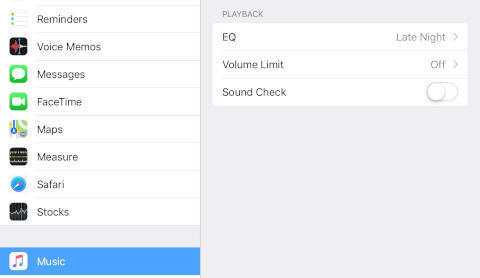
The Late Night EQ setting boosts the volume of quieter passages while at the same time reducing the volume of louder passages (again a compression-type limiter).
“Late Night” often does improve things quite a bit.
While it doesn’t work as well as increasing the input gain (as these booster apps do), you don’t have to install anything to try it.
Note: I am not suggesting that you should try to listen at unsafe sound levels, but merely compensate for recordings that are clearly too quiet.
If your earmuffs appear to be too quiet with virtually all music/audiobooks, this may be an indication that the environmental noise level is too high and you need higher-rated hearing protection rather than blasting music at a higher volume.
Conclusion
So which ones should you get?
If you want to emphasize sound quality and perhaps also want a radio, get the 3M Worktunes Connect + AM/FM. They sound best, offer the best safe volume control, and are the most versatile ones. They even have an easily accessible built-in equalizer. Their headband can be extended the most, making them suitable for even very large heads.
The 3M Worktunes Connect (without radio) are my second favorites. They don’t sound quite as good but still very pleasant to me. They are a bit lighter, a bit more comfortable, and the limiter works great for emphasizing quieter vocals and speech. And, they look really cool and don’t have a protruding antenna.
The Worktunes Connect also make for great economical study earmuffs.
If you need to make phone calls while working in a loud environment, get the Honeywell Sync Wireless earmuffs. These are the only ones that can separate speech from loud noise and they do it really well. They are lighter than both 3M earmuffs, comfortable and provide ample space for the ears. They don’t sound as good (they lack bass) as the 3M earmuffs but I can still get a lot of fun out of them. Unfortunately they are not as adjustable, so if you have a large head they may be on the small side.
If this review has helped you, I’d be glad if you could share a link to it on your favorite social network.
Have a happy and productive day.
Notes:
Noise reduction ratings and attenuation data as per earmuff packaging and insert.



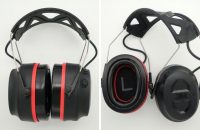
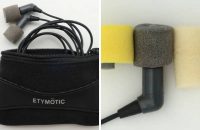
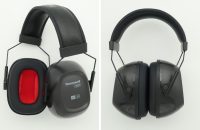

Really appreciate the detailed reviews!! Thanks so much
Hello Kevin,
thank you for stopping by and your feedback.
Have a great day.
Your link for the Honeywell headset goes to the listing for the RWS-53012, while the description seems to be for the 53016 (the 53012 has no Bluetooth). Can you confirm which model you reviewed?
Can you comment on the call/microphone quality of the 53012? The 53016 is difficult to find, and seems to be discontinued.
I’m looking for something that can silence office noise (I have a sensory disorder that makes open-plan offices a living hell) and still make professional-sounding phone calls.
Thanks so much!
Hello William,
thank you for your feedback.
I tested the 53016, the Sync Wireless with Bluetooth and Boom mic.
I checked the ASIN, and the link is actually the correct one for the Sync Wireless, but they have redirected it to the 53012, presumably because the 53016 is out of stock.
I wish they wouldn’t do that.
The 53012 has no Bluetooth and you would need an extra Bluetooth adapter to make a phone call (like with the Sync Stereo decribed in this post).
While I find the Bluetooth adapter described in this post quite good for making phone calls, in terms of noise handling it is no match for the Boom mic of the Sync Wireless.
At the Honeywell Store is says “currently unavailable” for the Sync Wireless.
So while there is no guarantee, it is entirely possible that the Sync Wireless headset becomes available again.
Alternatively, you could try the economical Worktunes Connect. They are excellent for blocking noise and OK for making calls. Unfortunately, they too don’t come close to the call quality of the Sync Wireless in a high noise environment. Still, as a noise blocker I feel they could work well for you.
If you need to make a lot of calls in a loud office, the Bose noise cancelling headphones 700 would also be a good option, albeit at a much higher price point.
All the best.